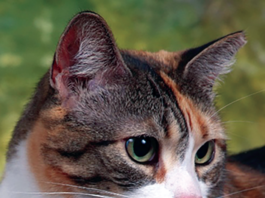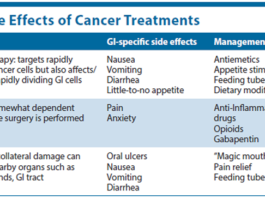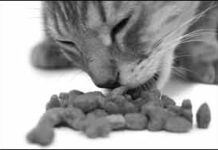Kitty cams reveal their hidden world
Two thousand hours of video recorded by “kitty cams” from the National Geographic Society have uncovered the lives of indoor cats who are allowed outdoors.
The Future Basis For Diet Plans: Genetics
Nutritionist Joseph Wakshlag, DVM, Associate Professor of Clinical Nutrition at Cornell University College of Veterinary Medicine, poses a question for owners: “If you knew that your cat would develop cognitive dysfunction at age 12, and if feeding him an antioxidant-enhanced diet would delay that development, wouldn’t you do it?” That scenario may be possible in the not-too-distant future. If scientists identify a gene for feline cognitive dysfunction — and a host of other diseases with genetic risk factors — individualized nutrition and lifestyle plans could be developed for cats based on their genetic tests. It has long been known that nutrition plays an important role in preventing and healing disease in humans, cats and dogs, but its role may be greater than we thought. Researchers in the pioneering science of nutrigenomics stand squarely at the intersection of genetics and nutrition.
Holiday Overload Can Affect Their Health
With shopping, traveling and entertaining, the weeks between Thanksgiving and New Year’s can be anything but relaxing. However, humans aren’t the only individuals to suffer holiday overload. Cats can also become stressed, and if prolonged, the stress can result in changes in health and behavior. “I could write a book about the physiology of stress,” says Germain F. Rivard, DVM, Ph.D., a resident in behavioral medicine at Cornell University College of Veterinary Medicine. “A cat under stress would change personality as he loses his coping mechanisms. Often, the reaction is avoidance with or without vocalizations, and if the cat cannot escape, he defends himself aggressively. That’s why it is important to create a safe place ahead of time.”
In The News: October 2012
Wollie, a 3 -year-old black cat, made national news when he walked six miles to find his way home from an animal shelter in Bedford, N.H. Barbara Oliphant had taken in the stray but gave him up when her husband became ill. When her husband improved, Oliphant’s daughter adopted Wollie as a surprise for her, but the cat escaped his carrier in the shelter parking lot. He appeared at Oliphant’s door three days later. The inevitable question: How did he do that? Behaviorist Katherine A. Houpt, VMD, at Cornell offers the likely explanation: “He was a stray and familiar with the area.”
A Commitment to Improving Well-being
Imagine veterinarians being able to sterilize feral cats by vaccination instead of surgery. Or to identify the connection between a relatively benign form of feline coronavirus and feline infectious peritonitis, which is nearly always fatal, with the hope of finding ways to diagnose and combat it. Or discover how and why vaccine-associated sarcomas may trigger DNA damage in some cats and how this damage may be used to predict which cases of the sarcomas are amenable to chemotherapy. These are just three of the many scientific studies funded by the Cornell Feline Health Center where, under the guidance of Director Colin Parrish, Ph.D., Professor of Virology, the goal of bettering the health of cats continues to be the focus and commitment, as it has been since the center opened its doors in 1974.
When Aggression Has a Physical Basis
Your cat is shy but generally sweet natured and affectionate. Imagine your shock, then, when you reach to pick him up and he tries to bite you — for no apparent reason. Did your cat’s inner tiger emerge? When the onset of feline aggression is sudden, there’s a good chance that the source could be a health problem, and you need to make an appointment with your veterinarian. “A medical cause for aggression in cats is relatively rare, but it must always be ruled out,” says Katherine A. Houpt, VMD, Ph.D., diplomate of the American College of Veterinary Behaviorists and emeritus James Law Professor of Animal Behavior at Cornell University’s College of Veterinary Medicine. “The primary cause of medically based aggression is pain, no matter what the source of that pain.”
Looking Beyond the Food Bowl
Bringing out the nutritional best in your cat goes beyond the food in the bowl. Frequency of meals, location, post-meal bowl cleaning and other environmental factors also influence his health. “One of the biggest problems is that far too many people overfeed their cats, and the cats become overweight and some even become obese,” says nutritionist Joseph Wakshlag, DVM, Ph.D., Associate Professor of Clinical Nutrition at Cornell University College of Veterinary Medicine. “Dogs give you those begging eyes when you sit down to eat, but in most cases, you can get them to go into another room and leave you alone.” They excel at begging. “Cats, however, are aggressive beggars. They will keep purring and meowing. If you tell them to go away, they will just come right back and start meowing again. They are more persistent than dogs and far too often, the person gets frustrated and will get up and put more food in their bowls.”
Feline Upper Respiratory Infections
Your seven-year-old cat is a generally healthy animal. Except for a fleeting bout of gastrointestinal upset a few years ago, shes never had a really serious sick-day in her life. But your neighbors cat always seems to be ill. Every couple of months, she shows up on your doorstep wheezing and sneezing. Her eyes are red and watery, and she acts lethargic. These disturbing signs persist for a week or so, but then she seems to be okay again - for a while. Its quite likely that the cat next door is suffering from an upper respiratory infection, a highly contagious disease affecting her nose, sinuses, pharynx and larynx - the structures that filter, heat and dehumidify inhaled air before it flows to her lungs. Why is it, you wonder, that your cat never experiences this problem, while the cat next door cant shake it?
Let Them Eat Cake! (Just Don’t Invite Your Cat.)
Sweetness is detected by a specific receptor protein (what we commonly refer to as a ‘taste bud’) in the tongue. Cats are known to be insensitive to sweet tastes, but the specific reason was not known until recently. Researchers analyzed the genes encoding the taste buds in twelve different carnivorous species, including cats (“Major taste loss in carnivorous mammals,” in Proceedings of the National Academy of Sciences, US, 2012 ). They found that those species such as cats — whose diet is exclusively meat-based — had lost the gene encoding the taste bud for sweetness.
Is Your Cat Afraid of Strange Noises?
Whenever cat owner Susan Lomond turns on her printer, her cat Sylvester dashes over to sit on it, lie on it and watch in fascination as the paper comes out. But when Susan’s friend Diana turns on her printer, her cat, Petra, flees in terror. Cats respond differently to noise depending on their personalities and experiences — and even their genetics. When cats get scared of noise, we often feel the need to soothe them. Actually, that may not be helpful. How to Help Your Cat. Cats differ from dogs when it comes to being frightened by noise. Dogs are notoriously afraid of thunder and fireworks, and will often try to escape from the house in a panic. Cats are more likely to be scared of unexpected noises around the house, such as the vacuum cleaner, construction work or a hair dryer. “But thunder and fireworks don’t seem to bother cats,” says Katherine A. Houpt, VMD, PhD, the emeritus James Law Professor of Animal Behavior at Cornell University’s College of Veterinary Medicine. “I have never seen fireworks or thunder phobia in cats,” she says.
Short Takes: August 2012
Most “trap-neuter-return” feral cat groups provide vaccines and other veterinary services prior to releasing them, according to a survey of 120 such groups conducted by Alley Cat Rescue, a feral cat TNR advocacy group.Ninety-six percent of the groups provide rabies vaccinations, while 64 percent provide distemper vaccinations. Twelve percent provide feline leukemia shots, 62 percent deworm feral cats and 64 percent provide flea treatment.The majority (96 percent) of feral cat groups neuter stray cats before placing them in homes, and most groups also provide spay and neuter services to owned cats to prevent future colonies from forming, according to Alley Cat Rescue. Feral cat groups’ efforts to educate the public about trap-neuter-release programs have been productive, with 65 percent of respondents calling their education efforts “somewhat” effective, and 18 percent finding their efforts extremely successful. Most animal control agencies do not offer trap-neuter-release programs (61 percent), and one in three agencies have trapped and killed whole colonies, according to respondents.
Let Them Eat Cake! (Just Dont Invite Your Cat.)
Sweetness is detected by a specific receptor protein (what we commonly refer to as a ‘taste bud’) in the tongue. Cats are known to be insensitive to sweet tastes, but the specific reason was not known until recently. Researchers analyzed the genes encoding the taste buds in twelve different carnivorous species, including cats (“Major taste loss in carnivorous mammals,” in Proceedings of the National Academy of Sciences, US, 2012 ). They found that those species such as cats — whose diet is exclusively meat-based — had lost the gene encoding the taste bud for sweetness.












